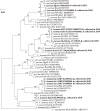Decline in Cryptosporidium Infection in Free-Ranging Rhesus Monkeys in a Park After Public Health Interventions
- PMID: 35873143
- PMCID: PMC9301329
- DOI: 10.3389/fcimb.2022.901766
Decline in Cryptosporidium Infection in Free-Ranging Rhesus Monkeys in a Park After Public Health Interventions
Abstract
Nonhuman primates (NHPs) are considered an important source of parasitic zoonoses. A study in 2010 revealed high prevalence of Cryptosporidium spp. in free-ranging rhesus monkeys (Macaca mulatta) in a public park in Guiyang, southwestern China, which called for the control of disease in animals and long-term epidemiological tracking of Cryptosporidium spp. After the initiation of a series of public health interventions, we collected 2,402 fecal samples from monkeys and 123 water samples from lakes in the park on six occasions during 2013-2019. They were analyzed and genotyped for Cryptosporidium spp. using PCR and sequence analyses of the small subunit rRNA gene. The C. hominis and C. parvum identified were further subtyped by sequence analysis of the 60 kDa glycoprotein gene. Compared with the high prevalence of Cryptosporidium spp. in fecal samples (10.9% or 45/411) and water samples (47.8% or 11/23) in 2010, only 18 (0.7%) fecal samples and 3 (2.4%) water samples collected in the present study were positive for Cryptosporidium spp., including C. hominis (n = 9) and C. parvum (n = 12). The former belonged to the NHP-adapted IfA17G2R3 subtype, while the latter mostly belonged to rodent-adapted IIpA9. Therefore, the detection rate and genetic diversity of Cryptosporidium spp. during this study period were much lower than those before the public health interventions, and there was a switch from common occurrence of anthroponotic C. hominis subtypes to sporadic occurrence of NHP-adapted C. hominis and rodent-adapted C. parvum subtypes.
Keywords: Cryptosporidium spp.; intervention; nonhuman primates; rhesus monkey; subtype; surveillance.
Copyright © 2022 Jia, Wen, Guo, Xiao, Feng and Li.
Conflict of interest statement
The authors declare that the research was conducted in the absence of any commercial or financial relationships that could be construed as a potential conflict of interest.
Figures



Similar articles
-
Subtyping of Nonhuman Primate-Adapted Cryptosporidium hominis in Macaca Fascicularis and Macaca mulatta in Yunnan Province, Southwestern China.Vector Borne Zoonotic Dis. 2023 Jul;23(7):364-370. doi: 10.1089/vbz.2023.0008. Epub 2023 Jun 15. Vector Borne Zoonotic Dis. 2023. PMID: 37326984
-
Molecular prevalence and subtyping of Cryptosporidium hominis among captive long-tailed macaques (Macaca fascicularis) and rhesus macaques (Macaca mulatta) from Hainan Island, southern China.Parasit Vectors. 2019 Apr 30;12(1):192. doi: 10.1186/s13071-019-3449-0. Parasit Vectors. 2019. PMID: 31039801 Free PMC article.
-
Common occurrence of divergent Cryptosporidium species and Cryptosporidium parvum subtypes in farmed bamboo rats (Rhizomys sinensis).Parasit Vectors. 2020 Mar 24;13(1):149. doi: 10.1186/s13071-020-04021-5. Parasit Vectors. 2020. PMID: 32204732 Free PMC article.
-
Distribution and clinical manifestations of Cryptosporidium species and subtypes in HIV/AIDS patients in Ethiopia.PLoS Negl Trop Dis. 2014 Apr 17;8(4):e2831. doi: 10.1371/journal.pntd.0002831. eCollection 2014 Apr. PLoS Negl Trop Dis. 2014. PMID: 24743521 Free PMC article.
-
Prevalence of human cryptosporidiosis in the Americas: systematic review and meta-analysis.Rev Inst Med Trop Sao Paulo. 2022 Nov 14;64:e70. doi: 10.1590/S1678-9946202264070. eCollection 2022. Rev Inst Med Trop Sao Paulo. 2022. PMID: 36383892 Free PMC article.
Cited by
-
Distribution of human-pathogenic Cryptosporidium spp., Giardia duodenalis, and Enterocytozoon bieneusi in crab-eating macaques in China.Front Microbiol. 2025 Jul 21;16:1641632. doi: 10.3389/fmicb.2025.1641632. eCollection 2025. Front Microbiol. 2025. PMID: 40761285 Free PMC article.
-
Ecosystem health appears neglected in the management of the human-macaque interface: A systematic review.One Health. 2024 Aug 20;19:100875. doi: 10.1016/j.onehlt.2024.100875. eCollection 2024 Dec. One Health. 2024. PMID: 39253387 Free PMC article. Review.
-
A review of recent Cryptosporidium hominis and Cryptosporidium parvum gp60 subtypes.Curr Res Parasitol Vector Borne Dis. 2025 Jul 6;8:100292. doi: 10.1016/j.crpvbd.2025.100292. eCollection 2025. Curr Res Parasitol Vector Borne Dis. 2025. PMID: 40734660 Free PMC article. Review.
References
-
- Checkley W., White A. C., Jr., Jaganath D., Arrowood M. J., Chalmers R. M., Chen X. M., et al. . (2015). A Review of the Global Burden, Novel Diagnostics, Therapeutics, and Vaccine Targets for Cryptosporidium . Lancet Infect. Dis. 15 (1), 85–94. doi: 10.1016/s1473-3099(14)70772-8 - DOI - PMC - PubMed
Publication types
MeSH terms
Substances
LinkOut - more resources
Full Text Sources
Medical
Miscellaneous

